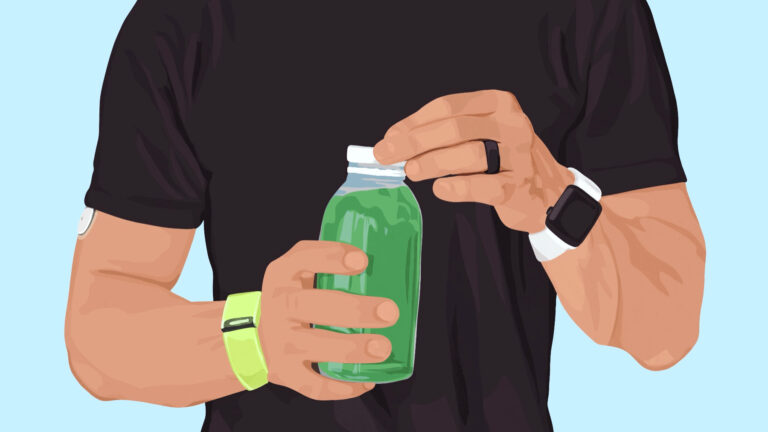As running and cycling boomed during the pandemic, road races and triathlons all but disappeared.
With billions of dollars at stake, the future of endurance events is in flux.
Where does the industry go from here? Let’s take a look.
A Bright Spot
When gyms closed, walking, running, and cycling caught on.
Between March and September last year, data from Fitbit, Garmin, and MapMyRun showed increased activity levels, as runners logged 22%, 31%, and 68% more miles, respectively.
For their part, runners on Strava logged 1.9B miles for the year. And cyclists pedaled through the pandemic, with Strava users biking more than 8B miles globally.
The cycling boom knew no bounds. Last April, sales for traditional bikes, indoor bikes, and cycling accessories were up 75% to $1B for a single month. Like free weights, bicycles, stationary bikes, and indoor bike trainers sold out. In some cases, they’re still out of stock.
Best of all, the boom wasn’t limited to long-time exercisers. According to Sports Business Journal, in the US, as many as 7M new runners hit the pavement last year.
Running’s Recession
Beyond potential health benefits, running’s resurgence is good news for another reason. Mainly, that participation in running events has been on the decline.
In 2019, the number of runners participating in organized races in the US was down 2.7% from 2018 to 17.6M. Nothing new, participation in recreational road racing has been on a downward trend for years since peaking in 2013, when 19M runners crossed the finish line.
In an effort to better understand the “running recession,” researchers at Temple University surveyed some 23K race participants, concluding:
“Participants are reporting less enjoyment and gratification from the physical act of running, placing less value on using running as a signal of self-concept and impression management, and reporting a diminished role of running as an important part of their life.”
A related development, according to the NYT, interest in triathlon has also cooled in recent years:
“The largest age group of triathletes is 45-49, and by 2018 membership in USA Triathlon, the national governing body in the sport, had dropped about 25 percent over five years.”
The Fallout
Around the world, countless races were canceled or drastically scaled back. Race organizers and local economies are reeling as a result.
According to the Endurance Sports Coalition, more than 50K events, attracting some 30M Americans, have been canceled through early 2021. Race organizers are set to lose $3B in revenue. And 500K jobs will be lost.
Host cities are also taking a hit. In 2019, the Boston Marathon brought in some $200M for the city. Chicago saw a $378M injection from its marathon. And the most recent analysis of the NYC Marathon put the economic impact at more than $400M.
Coronavirus put the brakes on IRONMAN Triathlon, too. In a typical year, the company holds more than 235 races in 50 countries. In 2020, only a handful of races went off as planned. The rest were postponed or canceled altogether, with IRONMAN refusing to issue refunds.
And Spartan Race encountered obstacles of its own. In early 2020, the company acquired rival Tough Mudder out of bankruptcy for $700K, assuming up to $10M in liabilities. Then, 90% of its revenue evaporated as races were canceled. To weather the storm, Spartan Race CEO Joe De Sena and Hearst Ventures recently invested $5.7M.
Going Virtual
An alternative to in-person events, virtual races filled a void.
Even if they weren’t actually in New York City, more than 25K people completed the city’s marathon last year. Connected via an app, and running independently within a two-week window, participants put in 26.2 miles.
According to New York Road Runners (NYRR), the non-profit organization behind the event, virtual races help keep runners motivated and engaged. And other organizers are getting on board.
Project Unbreakable, a virtual event from Spartan Race, attracted 40K participants. More than 160K runners competed in The Rock ’n’ Roll Marathon Series over 10 virtual races. And 18K participants finished Boston’s virtual marathon.
Strava data signals a shift in competition and community. Over 1M athletes joined the app’s monthly 5K challenge in May. In April alone, over 30K clubs were created and nearly 250K athletes joined clubs on Strava. Between January and September, 71M users joined challenges on the platform.
Endurance Meets Esports
The rise of virtual races opened the door for companies innovating on in-person events and exercise.
Leading the way, Zwift is building a digital world for cyclists and runners. From inception, the focus had been on software. But now, armed with $450M in new funding, the company is actively pursuing hardware and esports.
Last year, the company underwent a round of layoffs, restructuring with new hardware in mind. More recently, Zwift CEO Eric Min confirmed rumors the company is working on its own smart bike. The timeline is less clear, with Min saying “I wish yesterday” when pressed for a release date.
Meanwhile, this summer, the Virtual Tour de France was held on Zwift. Featuring dozens of the world’s top cyclists, the broadcast attracted 16M viewers in 130 countries. And more than 117,000 users rode the virtual course on Zwift, covering more than 3M miles.
In August, Zwift teamed up with Super League to host a unique, made-for-TV triathlon. And in December, Zwift hosted the inaugural UCI Cycling Esports World Championships. According to Min, “it’s only a matter of time before we see virtual racing as an Olympic sport.”
Looking Ahead
Olympics or not, reimagining endurance sports for the virtual world is an interesting, and growing, opportunity.
Some 60M Americans participate in running and jogging each year. The median household income of a runner is $112K. And the average income of a triathlete is over $125K/year.
While digital and connected fitness companies seek to replicate studio classes for would-be gym-goers, runners, cyclists, and multi-sport athletes represent a lucrative market — one that promises to reshape the metaverse of fitness.
In the meantime, treadmills could be the next battleground, as Peloton, Zwift, NordicTrack, and others look to reimagine running while broadening their customer base.
🎙 On the Podcast
This week, on the Fitt Insider podcast, we’re joined by Brian Kirkbride, co-founder and co-CEO of FitLab — an integrated holding company of performance lifestyle brands.
In this episode, we discuss:
- Evolving from a venture studio into a holding company
- Partnering with brands like XPT, McGregor FAST, and Freeletics
- Creating digital and in-person communities
- Redefining fitness offerings for a hybrid future
Listen to the full episode here.
👟 Walk It Out
Yesterday, Apple introduced Time to Walk — a new audio experience on Apple Watch for Fitness+ subscribers
Encouraging users to be more active, Apple enlisted celebrities to narrate audio-guided walks, launching with episodes from musician Shawn Mendes, NBA player Draymond Green, country music star Dolly Parton, and Emmy Award winner Uzo Aduba.
Why is this interesting? Simply walking more can deliver an array of benefits.
- A sedentary lifestyle costs the world $67.5B and 5M lives each year.
- Walking regularly, even below minimum recommended levels, lowers all-cause mortality.
- If all adults aged 18–64 walked 15 minutes more a day, the world economy would grow by an estimated $100B year-over-year.
Tapping a number of trends, Time to Walk is, well… timely. Walking was the top activity on Strava in 2020, increasing 3x. Situated somewhere between meditation apps and passively listening to a podcast, audio-guided walks could play into the mindfulness trend. And, like Calm’s Sleep Stories or Peloton’s partnership with Beyoncé, Apple is leveraging celebrities.
Two things: First, it’s a warning shot to digital fitness competitors. If Apple is enlisting athletes and celebrities for a walking feature, imagine what they’re prepared to do for fitness and well-being content down the road.
And two, encouraging people to walk more aligns with their broader focus on overall health and their design to be equipment agnostic, differentiating them from pure play fitness companies.
💸 Debt Dealings
A next-order effect of COVID-related closures, Equinox wants to rework looming debt obligations… in a hurry.
Last year, Equinox Holdings struck a deal with HPS Investment Partners, the lender to SoulCycle. At the time, Equinox guaranteed part of SoulCycle’s $265M credit line, delaying payment to February 15, 2021.
As the deadline approaches, Bloomberg is reporting that Equinox is in talks to push out the deadline again.
Punchline: While the dealmaking continues, S&P Global Ratings previously said: “We would view any further deferrals beyond Feb. 15, 2021, as tantamount to a default.”
For now, the company hopes its digital and at-home efforts can offset some of the losses stemming from prolonged closures. Looking forward to an omnichannel future, Equinox Media CEO Jason LaRose recently appeared on the Fitt Insider podcast, discussing the Variis app and SoulCycle’s at-home bike.
📰 News & Notes
- Apple readies a VR headset.
- The $600B menopause market.
- The future of outdoor recreation.
- Echelon partners with… Mario Lopez?
- Therabody settles patent infringement lawsuit.
- Nike’s new NbG line looks a lot like Madhappy.
- Hyperice debuted the “HyperTank” and Performance Advisors.
💰 Money Moves
- Bangalore, India-headquartered fitness company Cure.fit acquired Onyx, an AI-powered workout app.
- Talent Hack landed $4.7M for its B2C fitness platform, Spaces.
- Hurdle, a teletherapy platform providing culturally sensitive self-care support for People of Color, raised $5M in Series A funding.
More from Fitt Insider: Peak Burnout - Calibrate, a digital weight loss and metabolic health solution, raised $22.5M in a Series A funding round led by Threshold Ventures, with participation from Forerunner Ventures and Redesign Health.
- Opal, a digital well-being assistant for iOS, raised $4.3M in seed funding.
- Ryan Seacrest invested in connected fitness company CLMBR.
Listen in: CLMBR CEO Avrum Elmakis on the Fitt Insider podcast. - Eli, a women’s health and hormone tracking startup, closed $1.5M in seed funding.
- Spartan Race added $5.75M in funding from its CEO Joe De Sena and Hearst Ventures, an existing minority investor.
- Telehealth startup hims went public in a SPAC deal with Oaktree Acquisition Corp., valuing the company at $1.6B.
Listen in: hims CEO Andrew Dudum on the Fitt Insider podcast. - Flow Water is preparing for a public offering.
- Sproud closed $6.5M for its pea-based milk alternative.
More from Fitt Insider: The Quest for Cow-Free Milk - Cell-based seafood producer BlueNalu raised $60M in funding.
More from Fitt Insider: The Future of Meat - Sustainable grocery delivery company Imperfect Foods closed $95M in Series D funding.
- Swiss startup Mirai Foods closed a $2.4M seed round to accelerate the commercialization of its lab-grown meat.
- Blue Horizon Ventures closed a €183M ($222.6M) foodtech fund to back companies across alternative proteins, synthetic biology, cell-based food, smart packaging, and food waste categories.
- The Bountiful Co., a nutritional supplements maker owned by private equity firm KKR & Co., is preparing to go public at a value north of $6B.






